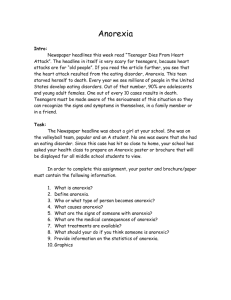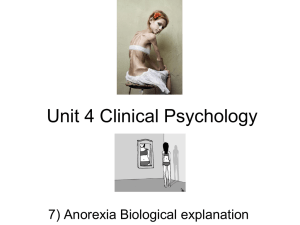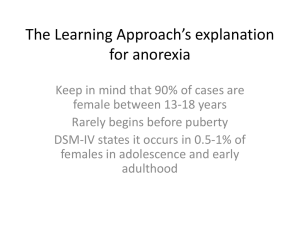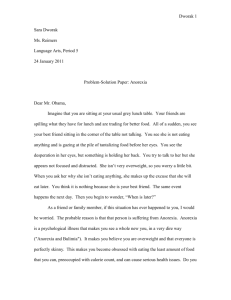Rhetoric of Anorexia
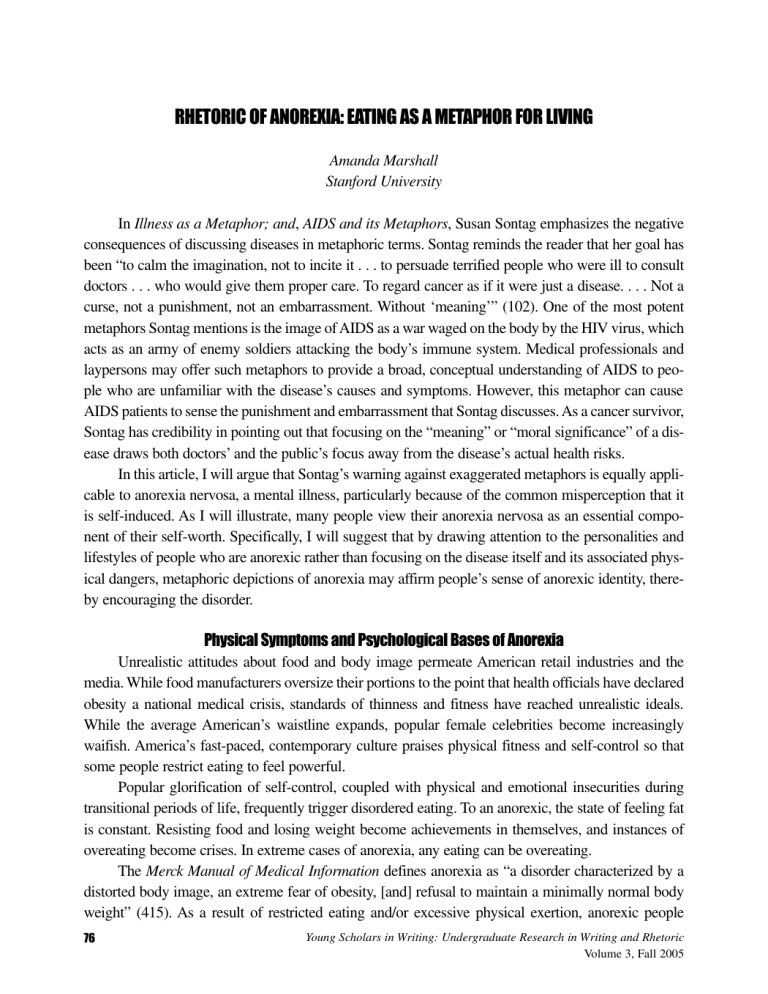
RHETORIC OF ANOREXIA: EATING AS A METAPHOR FOR LIVING
Amanda Marshall
Stanford University
In Illness as a Metaphor; and , AIDS and its Metaphors , Susan Sontag emphasizes the negative consequences of discussing diseases in metaphoric terms. Sontag reminds the reader that her goal has been “to calm the imagination, not to incite it . . . to persuade terrified people who were ill to consult doctors . . . who would give them proper care. To regard cancer as if it were just a disease. . . . Not a curse, not a punishment, not an embarrassment. Without ‘meaning’” (102). One of the most potent metaphors Sontag mentions is the image of AIDS as a war waged on the body by the HIV virus, which acts as an army of enemy soldiers attacking the body’s immune system. Medical professionals and laypersons may offer such metaphors to provide a broad, conceptual understanding of AIDS to people who are unfamiliar with the disease’s causes and symptoms. However, this metaphor can cause
AIDS patients to sense the punishment and embarrassment that Sontag discusses. As a cancer survivor,
Sontag has credibility in pointing out that focusing on the “meaning” or “moral significance” of a disease draws both doctors’ and the public’s focus away from the disease’s actual health risks.
In this article, I will argue that Sontag’s warning against exaggerated metaphors is equally applicable to anorexia nervosa, a mental illness, particularly because of the common misperception that it is self-induced. As I will illustrate, many people view their anorexia nervosa as an essential component of their self-worth. Specifically, I will suggest that by drawing attention to the personalities and lifestyles of people who are anorexic rather than focusing on the disease itself and its associated physical dangers, metaphoric depictions of anorexia may affirm people’s sense of anorexic identity, thereby encouraging the disorder.
Physical Symptoms and Psychological Bases of Anorexia
Unrealistic attitudes about food and body image permeate American retail industries and the media. While food manufacturers oversize their portions to the point that health officials have declared obesity a national medical crisis, standards of thinness and fitness have reached unrealistic ideals.
While the average American’s waistline expands, popular female celebrities become increasingly waifish. America’s fast-paced, contemporary culture praises physical fitness and self-control so that some people restrict eating to feel powerful.
Popular glorification of self-control, coupled with physical and emotional insecurities during transitional periods of life, frequently trigger disordered eating. To an anorexic, the state of feeling fat is constant. Resisting food and losing weight become achievements in themselves, and instances of overeating become crises. In extreme cases of anorexia, any eating can be overeating.
The Merck Manual of Medical Information defines anorexia as “a disorder characterized by a distorted body image, an extreme fear of obesity, [and] refusal to maintain a minimally normal body weight” (415). As a result of restricted eating and/or excessive physical exertion, anorexic people
76
Young Scholars in Writing: Undergraduate Research in Writing and Rhetoric
Volume 3, Fall 2005
become malnourished. They often lose over 25% of their normal body weight in a relatively brief period of weeks or months (416). Hormone imbalances and nutrient deficiencies cause the menstrual cycle to cease (amenorrhea) and bones to become less dense. In the long term, these physical symptoms can lead to sterility and severe osteoporosis. Anorexia particularly threatens physical health because so many patients are prone to relapses.
Typically, anorexia is associated with perfectionism, eagerness to please others, desire for attention, and emotional insecurity, and nearly 90% of anorexics are women. Anorexia usually develops when people with these characteristics face a stressful or transitional period in life, such as parents’ divorce, a loved one’s death, a move to a new school, or a painful breakup. Anorexia develops when a person channels all of these concerns about life into his or her eating patterns and unhealthy weight loss. For example, a person who feels overwhelmed by a stressful relationship with a parent may convince herself that if she can lose weight or restrict her eating, she will be happy. She replaces a complex, unresolved problem in her life with a new, more clear-cut dilemma on which to focus. In this way, a person with anorexia turns eating into a metaphor for living, and adherence to a certain pattern of eating becomes a measure of success.
In a study of 84 anorexia patients over a 21-year period, doctors revealed that only 39 of these patients were said to have a “good outcome” (Zipfel, et al. 1). This study suggests that early identification and treatment of anorexia are important for maximizing patients’ chances for recovery. In order for this identification to take place, the public must be informed about anorexia in a compelling yet accurate way.
Metaphorizing Anorexia
In response to the rise of anorexia among America’s young women, both the popular media and public health organizations have spoken out against the disorder, hoping to discourage people from developing it. Because it is a mental illness with a complex psychological basis, public confusion about the disease is common. However, many sources attempt to explain anorexia to the bewildered and concerned public by portraying the disorder in figurative language. In an anorexic person’s mind, food and eating patterns become his or her sole assertion of control over life. The primary danger of metaphorizing anorexia is encouraging the metaphoric mindset that forms the basis for the disease itself.
Anorexic behavior is itself a type of figurative language. It manifests the natural human tendency to understand or cope with a complex concept by representing it in a simpler, more concrete form.
As Sontag asserts, “Saying a thing is or is like something-it-is-not is a mental operation as old as philosophy and poetry, and the spawning ground of most kinds of understanding” (93). For this reason, anorexia is not simply a phenomenon generated by the contemporary American media’s praise of certain body types. The disorder is not a direct result of young women’s desire to “just be skinnier.”
Instead, it is a metaphoric pattern of living. To people who have the disease, anorexia is the manifestation of an abstract concept, a sense of control over one’s life situations through concrete actions, the literal control of food intake.
Marshall / Rhetoric of Anorexia
77
Anorexia as Glamour
Media references to anorexia, specifically in the context of celebrities’ fame and fortune, generate misunderstanding. Most recently, Mary-Kate Olsen’s highly publicized treatment for anorexia gave the disorder heightened media coverage. In People Weekly , arguably America’s most widely-circulated entertainment newsmagazine, a cover story about Mary-Kate’s disorder describes the red string bracelet that she frequently was photographed wearing in the weeks leading up to her admission to a treatment center. The article notes that many people with anorexia wear red string bracelets “as a signal of their ‘ana’ pride and to remind themselves not to eat” (Tauber 3). It also features a glamorous photograph of Mary-Kate and Ashley Olsen at the Hollywood Walk of Fame. Mary-Kate’s bracelets may or may not have been worn as symbols of anorexia. However, by mentioning their symbolism as a possibility, the article suggests that anorexia offers some people a sense of community or “pride.”
More obviously, the photograph on the Walk of Fame juxtaposes Mary-Kate’s sickly physical condition with otherwise desirable circumstances. Especially among young readers, this may create an impression, even a subtle, unconscious notion, of anorexia as a metaphor for a high-pressure yet highprofile lifestyle and as an integral component of Mary-Kate’s fame and fortune. By publicizing anorexics’ metaphoric behavior, the article risks glamorizing the disorder.
Anorexia Oversimplified and Overdramatized
Even well-intentioned attempts to raise public awareness of anorexia can affirm anorexics’ hyperbolic, romanticized image of their own lives and discourage them from seeking treatment. A public service announcement recently created by the National Eating Disorders Association relies almost entirely on emotional appeals in order to raise its audience’s awareness about eating disorders.
Grim music plays in the background, and all clips are shown in black and white. This overdramatization implies that, like the announcement’s video imagery, eating disorders are black and white. Either a person is completely healthy, or he or she is in immediate danger of physical death from an eating disorder.
The public service announcement features testimony from parents who recall the shock and concern they experienced upon learning their children have an eating disorder. This aspect of the announcement appeals to viewers who are parents and may identify with the emotions of the parents offering testimony. However, people often develop anorexia as a result of their desire for affection from loved ones they believe are ignoring them. They may fear the responsibilities of adulthood. Many of these people turn to anorexia as a means of delaying puberty, indicating a desire for parental attention and nurturing (Mayo Clinic 1019-1020). Despite its purpose of raising awareness among parents of potential eating disorder patients, the public service announcement may provide affirmation to young people that anorexia is a means of manipulating loved ones’ emotions and increasing parental concern and attention.
Anorexic Self-Expression
Some anorexics turn to various communication modes to express their anorexia metaphorically.
One survivor of anorexia notes that eating disorders have “a language that is as foreign as Chinese speech would be to a native Russian . . . substitute the verb ‘live’ wherever the verb ‘eat’ appears and
78 Young Scholars in Writing
substitute ‘life’ in place of the world ‘food’” (Hooper 1). Many anorexic people also turn to modes of artistic expression to cope with their overwhelming emotions. Instead of helping anorexic people to channel their concerns in constructive ways, these modes of expression can further distort not only anorexic people’s own self-perception but also other people’s understanding of the disorder.
In artistic work describing experiences with anorexia, metaphors tend to downplay the physically lethal aspects of the disease. Micah Twaddle’s poem “Voices,” published in Chicken Soup for the
Teenage Soul III , brings the audience into the anorexic’s mind: the “voices . . . are saying,/If she eats she will gain,/And be way too fat to be loved” (251). In this case, representation of anorexia as internal voices reinforces the notion that it is “all in the person’s head.” As Sontag argues, “Victims suggest innocence. And innocence, by the inexorable logic that governs all relational terms, suggests guilt” (99). In this case, the poem may portray anorexia as a condition which patients are “guilty” of inducing or even imagining.
Many anorexic people, primarily young women, form online support groups to encourage each other to maintain their disorders. Because obsession is the norm in these communities, online readers and writers quickly become accustomed to speaking in metaphoric terms. The most common types of metaphors in these communities personify anorexia as an entirely separate self. Users also metaphorize their relationships to this “person” through the aliases under which they write. In the online LiveJournal community “Anorexia Haven,” usernames of members include “_notperfectyet_,”
“my_star_ana,” “strongana,” and “thinocence.” Many members of anorexia support communities perceive their disorder as a pivotal aspect of their identity. Their usernames become alter egos, and online journals allow anorexia to assume a separate persona.
The Community Information page of “Anorexia Haven” features pictures of Mary-Kate Olsen and several other willowy models and celebrities who apparently are primary sources of “thinspiration.” The community’s creator warns, “If you don’t have an ED [eating disorder] then LEAVE! . . .
This community was created to try and eliminate the ‘wanna be’s’ and support each other to perfection. . . . Don’t just think thin, BE thin!” Below this warning, the creator asks members to list their current, highest, and lowest weights. While recognizing that they have a labeled disorder, members create an exclusive society in which anorexia provides a metaphor for each member’s life.
Some journal entries personify anorexia in order to convey a love-hate relationship with the disease. In one LiveJournal posting, a writer under the username of “this_thin” composes a “Prayer to
Ana,” pleading, “In your cruelty, grant me the intellect to recognize you, the perception to dissemble about you, and the naiveté to appreciate you. In your cruelty endow me the perfectionism to seek you, the guile to disguise you, the strength to withstand stabbing hunger pains, and the vulnerability to accede you.” For her, anorexia plays a role similar to religion. She specifically asks for naiveté and vulnerability, indicating that, on some level, she recognizes anorexia’s dangers. Nevertheless, “this_thin” remains loyal to anorexia, trusting that if she is faithful enough, she will achieve contentment. Just as pious people turn to their deity for deliverance when life’s obstacles appear insurmountable, many young women cling to anorexia as a psychological and spiritual defense. By metaphorizing perfection with starvation, anorexic people view their restricted, controlled eating patterns as a means of salvation.
Marshall / Rhetoric of Anorexia
79
Breaking the Cycle
To prevent young American women from developing anorexia, media and health organizations have a responsibility to re-evaluate the manner in which they present information to the public.
Anorexia must not be portrayed in ways that make it appealing. Celebrities’ cases of anorexia can serve as valuable lessons about the disorder instead of as advertising campaigns for it. Specifically, when covering a celebrity’s disorder, news sources should not publish these people’s most flattering, glamorous photographs since anorexia is surely not synonymous with glamour. Rather, these articles should emphasize the negative consequences of anorexia, such as how Mary-Kate Olsen’s plans to attend college away from home might have changed if she had not sought treatment.
In the case of online journals and other means of publication through which anorexic people metaphorize their own condition, it is more difficult to determine the degree to which metaphorization should be restricted. While some particularly destructive pro-ana websites have been shut down, it would be unrealistic to attempt to eliminate all potentially harmful web pages, particularly personal journals. In order to prevent anorexia rates from rising among young American women, it is essential to understand people’s complex motivations for creating these online communities in the first place.
Both online journals and books offer a constructive, artistic means of self-expression that might actually help some anorexic people come to terms with their disorder. Instead of channeling their frustrations through obsessively restrictive eating patterns, anorexic people might create poetry, essays, or pictures that confront the underlying causes of these frustrations more directly. Editors of anthologies should carefully discriminate between submissions that acknowledge anorexia’s physically and emotionally harmful nature and those that romanticize it without offering new insights about the condition.
Perhaps metaphors of anorexia that portray the disorder more realistically can actually help people to address anorexia in a constructive way. In “I Just Wanted to Be Skinny,” also in Chicken Soup for the
Teenage Soul III , a writer reflects on her experience of having a friend with anorexia. The author mentions that her friend had looked like “a twig that could be snapped with the . . . wind” and was in danger of a heart attack (Bloor 253-54). Essays such as this one, which incorporate metaphoric language to offer an outsider’s perspective and to emphasize anorexia’s health risks, might provide more insight about the realities of the disease.
As Sontag warns her readers, “all thinking is interpretation. But that does not mean it isn’t sometimes correct to be ‘against’ interpretation” (93). Carefully monitoring certain means of communication, such as the online forums cited previously, might prevent anorexic people from encouraging each other to maintain their disorder. However, a virtually infinite variety of publication media are available through which anorexic people may metaphorize and romanticize their condition. Restricting free speech within one communication medium may simply cause people to turn to other media. Moreover, stringent regulation encroaches upon the positive aspects of free speech that make objective, factual information about anorexia readily available. Ultimately, just as the media has a responsibility to portray anorexia informatively, individuals have the responsibility to interpret these portrayals critically.
Nevertheless, within America’s culture of extremes, if media sources continue to metaphorize anorexia with language that strays from the reality of the illness, people will continue to metaphorize themselves with eating and stray from the reality of their own lives.
80 Young Scholars in Writing
I would like to thank Professor Melissa Marconi, my Writing and Rhetoric instructor at Stanford.
Works Cited
“Ana Vitality.” LiveJournal Community Information . 22 Nov. 2004.
<http://www.livejournal.com/userinfo.bml?user=_ana_vitality_>.
Anonymous. “Ana Prayer.” Online posting. 28 Nov. 2004.
Anorexia Haven .
<http://www.livejournal.com/community/_ana_vitality_>.
Bloor, Laura. “I Just Wanted to Be Skinny.” Canfield, Hansen, and Kirberger 251-52.
Canfield, Jack, Mark Victor Hansen, and Kimberly Kirberger, eds.
Chicken Soup for the Teenage Soul III . Deerfield Beach,
FL: Health Communications, 2000.
Hooper, Kim. “Recovery from Anorexia: A Journey of Growth.” OBGYN.net
. Ed. Barbara Nesbitt. 14 Nov. 2004.
<http://www.obgyn.net/displayarticle.asp?page=/yw/articles/anorexia_hooper>.
Mayo Clinic.
Mayo Clinic Family Health Book . Ed. David E. Larson, M.D. New York: William Morrow, 1990. 1019-20.
Merck & Co.
The Merck Manual of Medical Information . Ed. Robert Berkow. New York: Pocket, 1997. 415-16.
Sontag, Susan.
Illness as a Metaphor; and, AIDS and its Metaphors . New York: Picador, 1990.
Tauber, Michelle, et al. “Mary-Kate’s Private Battle.” People Weekly . 24 June 2004.
<http://people.aol.com/people/articles/0,19736,656348,00.html>.
Twaddle, Mica. “Voices.” Canfield, Hansen, and Kirberger 251-52.
Zipfel, Stephan, et al. “Long-Term Prognosis in Anorexia Nervosa: Lessons from a 21-Year Follow-Up Study.” The Lancet
355.9205 (2000): 721-22.
Marshall / Rhetoric of Anorexia
81

